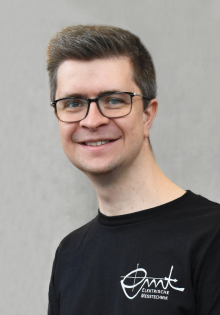Vermiedene Kreuzungen von Lamb-Wellenmoden in mehrlagigen Strukturen
DFG Projektnummer:
449607253
Kurzfassung:
In diesem Projekt wird eine zerstörungsfreie Prüfmethode zur Charakterisierung der Kopplungsfestigkeit zwischen zwei Schichten entwickelt, wobei die in den Dispersionskurven von mehrschichtigen Strukturen auftretenden Modenabstoßungsbereiche verwendet werden sollen. Nach Wissen der Autoren ist das aktuelle Projekt der erste Versuch, die Modenabstoßung in Bezug auf die Kopplungsstärke zu verstehen und zu charakterisieren. Die Hypothese ist, dass die Kopplungsstärke zwischen zwei Schichten durch Messung des Abstands zwischen zwei gekoppelten Moden in einer Modenabstoßungsregion in Bezug auf die Frequenz oder Phasengeschwindigkeit (Wellenzahl) charakterisiert werden kann. Im Rahmen des Projekts wird der Zusammenhang zwischen der Modenabstoßung und der Kopplungsstärke untersucht und quantifiziert. Um das Ziel des Projekts zu erreichen, werden sowohl numerische als auch experimentelle Untersuchungen durchgeführt. Die BAM verfügt über große Erfahrung in der numerischen Modellierung, insbesondere mit der im Projekt zu verwendenden Scaled Boundary Finite Element Methode, und wird die notwendigen zerstörenden Prüfungen für die Validierung der im Projekt zu entwickelnden zerstörungsfreien Methode bereitstellen. EMT verfügt über jahrelange Erfahrung in der Entwicklung der Messmethoden, insbesondere der akustischen Materialparameterbestimmung und den Einsatz inverser Verfahren, die ein weiterer wichtiger Aspekt des Projekts sind. Die Kombination der Kompetenzen und Erfahrungen beider Institutionen im Projekt wird nicht nur in der Wissenschaft, sondern auch in der Industrie einen wichtigen Beitrag zur zerstörungsfreien Charakterisierung der Qualität von Klebeverbindungen leisten.
Kooperationspartner:
Dr.-Ing. Jens Prager (Bundesanstalt für Materialforschung und -prüfung, Berlin)
Projektlaufzeit:
2020 bis 2023
Ansprechpartner
Projektbezogene Publikationen
Analysis of Lamb wave mode repulsion and its implications to the characterisation of adhesive bonding strength
Y. Lugovtsova, S. Johannesmann, B. Henning, J. Prager, in: 2019 International Congress on Ultrasonics, Acoustical Society of America, Bruges, 2019.
Quantifying the coupling strength of adhesively bonded materials by investigating mode repulsion regions
H. Zeipert, S. Johannesmann, M. Nicolai, Y. Lugovtsova, J. Prager, B. Henning, in: Fortschritte Der Akustik - DAGA 2021, 2021.
К ОПРЕДЕЛЕНИЮ ПРОЧНОСТИ КЛЕЕВОГО СОЕДИНЕНИЯ В МНОГОСЛОЙНЫХ МАТЕРИАЛАХ ПУТЕМ ИССЛЕДОВАНИЯ ОБЛАСТЕЙ РАСТАЛКИВАНИЯ БЕГУЩИХ УПРУГИХ ВОЛН
Y. Lugovtsova, H. Zeipert, S. Johannesmann, M. Nicolai, J. Prager, B. Henning, in: МАТЕМАТИЧЕСКОЕ МОДЕЛИРОВАНИЕ В ЕСТЕСТВЕННЫХ НАУКАХ - XXX Всероссийская Школа-Конференция, Perm, 2021.
Investigating peculiarities of piezoelectric detection methods for acoustic plate waves in material characterisation applications
L. Claes, H. Schmiegel, C. Grünsteidl, S. Johannesmann, M. Webersen, B. Henning, Tm - Technisches Messen 88 (2021) 147–155.
Measurement and Simulation of Lamb Waves in Adhesive-bonded Multilayer Systems
H. Zeipert, L. Claes, S. Johannesmann, M. Webersen, Y. Lugovtsova, J. Prager, B. Henning, in: 2021, pp. 91–92.
An approach to adhesive bond characterisation using guided acoustic waves in multi-layered plates
H. Zeipert, L. Claes, S. Johannesmann, Y. Lugovtsova, M. Nicolai, J. Prager, B. Henning, At - Automatisierungstechnik (2021) 962–969.
Quantification of the adhesive coupling of layered structures using guided ultrasonic waves
M. Nicolai, H. Zeipert, Y. Lugovtsova, J. Bulling, S. Johannesmann, J. Prager, B. Henning, in: Fortschritte Der Akustik - DAGA 2022, 2022, pp. 1394–1397.
Lamb wave based approach to the determination of acoustic material parameters
S. Johannesmann, L. Claes, N. Feldmann, H. Zeipert, B. Henning, Tm - Technisches Messen 89 (2022) 493–506.
Estimation of viscoelastic material parameters of polymers using Lamb waves
S. Johannesmann, L. Claes, B. Henning, in: Fortschritte Der Akustik - DAGA 2022, 2022, pp. 1401–1404.
Investigation of change in dispersive behaviour during adhesive curing in multi-layered structures
H. Zeipert, C. von Germeten, O. Friesen, L. Claes, S. Johannesmann, B. Henning, in: Fortschritte Der Akustik - DAGA 2023, 2023, pp. 819–822.
Characterization of adhesion strength using guided ultrasonic waves
M. Nicolai, H. Zeipert, Y. Lugovtsova, J. Bulling, S. Johannesmann, J. Prager, B. Henning, in: Fortschritte Der Akustik - DAGA 2023, 2023, pp. 823–826.
Beschreibung des akustischen Verhaltens verklebter plattenförmiger Strukturen mittels Kopplungsmodellen
H. Zeipert, J. Hölscher, L. Claes, B. Henning, in: D. Gesellschaft für Akustik e.V. (Ed.), Fortschritte Der Akustik - DAGA 2024, 2024, pp. 640–643.
On the repulsion effect of coupled Lamb wave modes
M. Nicolai, J. Bulling, Y. Lugovtsova, H. Zeipert, J. Prager, B. Henning, in: D. Gesellschaft für Akustik e.V. (Ed.), Fortschritte Der Akustik - DAGA 2024, 2024, pp. 632–635.
On the repulsion effect of coupled Lamb waves modes
M. Nicolai, J. Bulling, Y. Lugovtsova, H. Zeipert, J. Prager, B. Henning, in: Amsterdam, 2024.
Dynamic interface behavior in coupled plates: Investigating Lamb wave mode repulsion with a spring-based model
M. Nicolai, J. Bulling, M.M. Narayanan, H. Zeipert, J. Prager, B. Henning, Ultrasonics 158 (2025).
Monitoring the curing process of adhesive bonds using selective excitation of guided ultrasonic waves
H. Zeipert, T. Nellius, N. Schönlau, M. Wippermann, L. Claes, M. Nicolai, J. Prager, B. Henning, in: 2025 International Congress on Ultrasonics, AMA Service GmbH, 2025, pp. 207--210.
Alle Publikationen anzeigen


